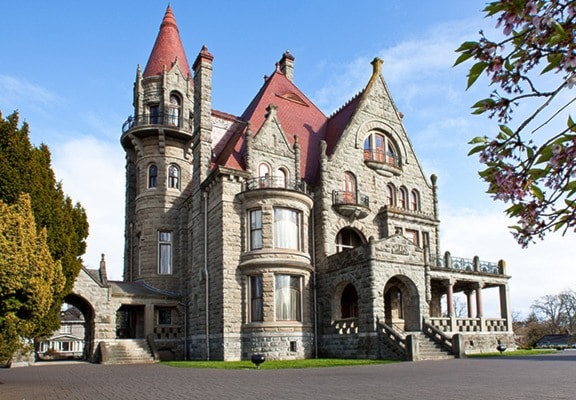As I noted several years ago, a highlight of the 2007 Heritage House Tour was 1860 Thain Rd., Cobble Hill. It’s the legacy of gentleman farmer Griffiths R. Hughes who liked to do things on a grand scale. His Frondeg Farm was big, his manor house was big, even his cook’s house was big. And when it was discovered that he’d done all this with stolen money, he was sentenced to five years in a really, really big house, courtesy of the province.
The Pimbury brothers, John, Augustus and Edwin, were the first to see potential in the property’s original 400 acres, much of it rich bottomland, in 1862. During their tenure it became known as Daisy Farm for the oxeye daisy they planted there and which, from a single package of seeds, flourished and flourished and...
They built several dwellings and a large barn, cleared fields and planted an orchard, then had to all but start over when land clearing accidentally set the peat bog on fire. They sold in the 1880s to a Capt. Thain who had no desire to farm but wanted the property for a summer residence. Hence “Thain’s Place” hence Thain Road. But, by 1903, the farm was rundown. It was revitalized by James Gosnell who then sold to Griffiths Hughes.
A Welshman who’d come to Canada in 1899 and friend of future British prime minister Lloyd George, he apparently did well in real estate in Vancouver before moving to Victoria to hang his shingle as a chartered accountant and becoming the senior accountant for David Spencer Ltd., operators of a Victoria department store. In 1917 he also bought the Victoria Daily Times and, already the owner of a Cobble Hill farm, he purchased the neglected Capt. Thain estate, renamed it Frondeg and set about building a model operation with imported purebred cattle on 100 cleared acres. More ambitious was a 1,000-foot-long irrigation canal, much of it blasted through solid rock.
In 1909 he commissioned construction of “a pretty little bungalow” (the future cook’s house). Five years later, an eight-man crew commenced building a 4,000-square-foot mansion. Only the best materials imported from England were used, the five massive chimneys that dominate its exterior and the five fireplaces requiring the skills of Italian bricklayers at a cost of $26,000. You can multiply that by 20 today!
During the First World War, when the government was seeking suitable sites for hospitals for recovering servicemen, Hughes generously offered the use of Frondeg Farm, an offer graciously declined.
Upon the death of Joan Dunsmuir, widow of coal baron Robert Dunsmuir, Hughes bought fabled Craigdarroch Castle to subdivide its 26-acre grounds into lots.
Alas, Hughes’ publishing and farming empire collapsed about him when an auditor (in his own employ, ironically) discovered discrepancies in the Spencer books. They seemed reasonably small: $24,000 deposited instead of $25,000, for example. But they added up — $325,000 by his own admission, a sizable fortune.
Charged with four counts of embezzlement, his preliminary hearing on July 16, 1920 created a sensation. “Crowds clung around the police station and police court until the hearing before Magistrate Jay was finished,” reported Hughes’s own newspaper. “As many as could get in the courtroom stood for the full five hours of the hearing. Extra police had to be put on duty outside the police station to keep the crowds back from the entrances. At one time a couple of hundred persons were gathered in the street in front of the station.
“Women were persistent in trying to force their way through the crowds and get into the court. So many tried to jam on the fire escapes and listen through windows that it was feared the escapes might collapse...”
Hughes testified he’d started embezzling on a small scale but that like everything else he did it just grew. Facing criminal trial and disgrace, he’d contemplated shooting himself. However, after writing three farewell letters, he decided to read a book before ending it all; by the time he finished the unidentified volume, he’d changed his mind. He surrendered ownership of the Times to the Spencer family who didn’t really want it but were stuck with it for 20 years under management of their sleuthing accountant. Hughes, by placing Frondeg Farm and other properties in a trusteeship, made full restitution.
His trial, for all its having been eagerly awaited by the public, proved to be anti-climactic when his counsel, H.A. McLean, KC, having presented no evidence for the defence, simply entered a plea of guilty and asked for clemency. Convicted on seven counts, Hughes took his sentence, five years on each count, to be served concurrently, “stoically.” He died in obscurity, aged 75, in Vancouver in 1941.
Although christened Frondeg Farm by Hughes, it was better known to locals as Heather Farm for the flourishing shrubs originally planted during his tenure and which (like those damned daisies) soon spread. There have been other owners over the years and, it’s rumoured, a visit by the Prince of Wales. In 1994 the movie Little Women was filmed at Heather Bank Farm.
Now down to 11 acres, the former Frondeg Farm and its handsome arts-and-crafts farmhouse (not to mention the former cook’s house) were a highlight of a 2007 Heritage House Tour.
Last month, Craigdarroch Castle Society’s executive director was interviewed in the Times-Colonist about the purchase of a house on a bordering property for use as an administrative centre. His name: John Hughes. You don’t suppose that he’s any relation to...?
www.twpaterson.com
